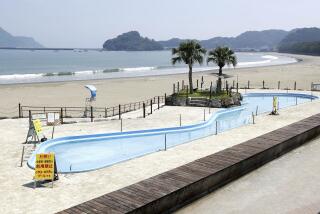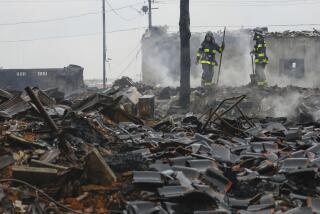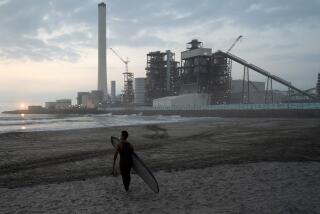U.S. nuclear officials suspect Japanese plant has a dire breach
- Share via
Reporting from Los Angeles, Kesennuma and Tokyo — U.S. government nuclear experts believe a spent fuel pool at Japan’s crippled Fukushima reactor complex has a breach in the wall or floor, a situation that creates a major obstacle to refilling the pool with cooling water and keeping dangerous levels of radiation from escaping.
That assessment by U.S. Nuclear Regulatory Commission officials is based on the sequence of events since the earthquake and information provided by key American contractors who were in the plant at the time, said government officials familiar with the evaluation. It was compelling evidence, they said, that the wall of the No. 4 reactor pool has a significant hole or crack.
Unlike the reactor itself, the spent fuel pool does not have its own containment vessel, and any radioactive particles and gases can more easily spew into the environment if the uranium fuel begins to burn. In addition, the pool, which contains 130 tons of uranium fuel, is housed in a building that Japanese authorities say appears to have been damaged by fire or explosions.
Photos: In Japan, life amid crisis
A breach in the pool would leave engineers with a problem that has no precedent or ready-made solution, said Edwin Lyman, a physicist with the Union of Concerned Scientists.
“My intuition is that this is a terrible situation and it is only going to get worse,” he said. “There may not be any way to deal with it.”
The struggle to cool down stricken nuclear reactors and spent fuel pools in northern Japan entered a second week Friday, with fluctuating radiation levels and blustery winds hampering efforts to douse the most damaged installations with water from military helicopters and firetrucks with high-powered hoses.
Military firetrucks repeated the spraying operations of the day before, but the Defense Ministry said the use of helicopters again Friday was unlikely. Workers also hoped to hook at least two of the reactors up to the electrical grid in the course of the day, which would aid in cooling efforts.
In a sign of the worsening crisis at the complex 150 miles north of Tokyo, Japan said Friday that it would accept American assistance in stemming the cascade of nuclear woes.
Yukiya Amano, head of the United Nation’s International Atomic Energy Agency, arrived in Japan Friday with a monitoring team and called the situation at the Fukushima plant “grave and serious,” Reuters reported.
With some devastated stretches of coastline still untouched by recovery teams, the official toll of dead and missing in last Friday’s magnitude 9 earthquake and ensuing tsunami topped 15,000, as hundreds of thousands of stranded survivors coped with freezing temperatures and shortages of fuel, food and other basic necessities.
Post-quake deaths, particularly among the frail, ill and elderly, were on the rise in sometimes primitive shelters. As of early Friday, the official death toll stood at 5,692, according to the National Police Agency, and 9,522 were unaccounted for and feared dead.
Radioactive levels at the plant had fallen by midday Friday and were not at levels that would affect human health, Cabinet Secretary Yukio Edano said. The army and Tokyo Electric Power Co., which operates the plant, were still trying to assess the success of the previous day’s efforts, he said.
“Information from the front line is emerging in fragments,” he said, adding that wind, rain, snow and topography were all factors.
The exodus of foreigners from Japan gathered momentum, with several governments advising their nationals to not only leave the quake zone but also depart from the capital or the country altogether. In Washington, the State Department reported the first evacuation flights of U.S. citizens, though the American advisory is narrower than that of other Western nations, including Britain and France.
As many Japanese sought refuge within their homeland, they put more distance between themselves and the nuclear complex, packing aboard trains headed south. The national fear is of a full-scale meltdown at the reactors in Fukushima prefecture, although prevailing winds would probably disperse much of a massive radiation release over the Pacific Ocean.
President Obama has assured Americans that the crisis did not pose a risk to U.S. territory.
The crisis was roiling financial markets worldwide. Of particular concern in Japan was the yen hitting record highs against the dollar as currency traders bet that Japanese companies and investors will sell foreign assets to pay for rebuilding.
Estimates of quake losses run to $200 billion, and a flow of money back into the country would boost demand for the yen, putting even more upward pressure on the currency, in turn making Japan’s exports more expensive for foreign buyers.
In a highly unusual move, finance ministers of the world’s wealthiest economies agreed to act together to stop the yen from rising, hoping to avert more damage to the Japanese economy.
The situation at the Fukushima reactors continued to be a major concern. Fuel rods at the core of at least three of the six reactors there are believed to have at least partially melted. Plant operators have had to vent radioactive gases, but no major release has been confirmed.
Japanese public statements, however, did not describe the No. 4 reactor as the most urgent task confronting emergency workers. “Cooling the No. 3 reactor is still our top priority,” Edano said in a briefing on national television.
But outside nuclear experts say the spent fuel pool may be the most serious long-term problem.
Nuclear fuel in the No. 4 reactor was moved to the spent fuel pool in December 2010, while the unit was being serviced, and that fuel remains highly radioactive. When a fire or explosion — officials aren’t sure which — left a hole in the secondary containment building this week, most experts concluded that the spent fuel pool had somehow lost water, exposing the fuel rods.
An exposed fuel rod can interact with air and steam, allowing the zirconium cladding to oxidize and produce highly flammable hydrogen gas.
It’s not clear how the rods became exposed to air in the first place. Scientists say the cooling water may have sloshed out of the pool during the earthquake, boiled away because of built-up heat or leaked from a crack in the pool.
Nuclear plant experts interviewed by The Times on Thursday said it was unlikely that the quake could have caused a significant amount of water in the 45-foot-deep pool to slosh out and drain away, exposing the 15-foot rods. They also doubted that heat from the fuel rods could boil away that much water in just a few days, especially because steam was not seen coming from the reactor building.
Instead, U.S. officials believe that the pool’s wall was cracked either by the intense shaking of the earthquake or by a large piece of equipment falling into it.
Employees of a consortium of General Electric and Hitachi were in the reactor building at the time of the quake, according to company and government sources. The GE employees have returned home, though some Hitachi employees are continuing to offer assistance to Tokyo Electric.
Nuclear experts say they can’t be positive that a breach has occurred without looking at the pool, but the area around the pool is so radioactive that a close inspection still isn’t possible.
The Nuclear Regulatory Commission’s chairman, Gregory B. Jaczko, said this week that his agency believed the spent fuel pool was empty, triggering alarms and a rebuttal by Japanese authorities. His spokesman, Scott Burnell, said Jaczko’s statements were “based on a variety of sources that represented the best available information.”
Electricity supplies across much of Japan have become a worrying element of the multi-pronged crisis. A massive threatened blackout was averted Thursday, but rolling power cuts and voluntary conservation areas are still leaving a shortfall. In the quake zone, Japanese officials said tens of thousands were still without power in unseasonably cold weather. An additional 1.6 million households still do not have running water.
The shortage of gasoline has forced businesses far from the disaster zone to close down and has slowed deliveries of urgently needed humanitarian aid to earthquake and tsunami victims.
As snow fell over Sendai, one of the quake zone’s largest cities, people under umbrellas waited in long lines that snaked around blocks to enter the few supermarkets that were open. Gas lines stretched more than a mile.
“This is the biggest disaster since World War II, and they are totally paralyzed,” said Kit Miyamoto, a Japanese American structural engineer who was inspecting damage in tsunami-ravaged Kesennuma.
One shortage often spawned another; people staying in shelters could not get food because they could not drive around looking for it. People used up gas looking for gas.
“The refugees in the sports center are lacking food. If they had the gasoline, they could drive somewhere to get food, but they are stuck here,” said Muneo Saijo, a shopkeeper who was helping evacuees in Kesennuma.
Even a week after the start of the crisis, many struggled to comprehend the level of privation in wealthy Japan.
“We’re an affluent country,” said Masahiko Nagaska, a 32-year-old Panasonic employee in Yamagata, in the heart of the earthquake zone. “But there’s no food on the shelves.”
Photos: In Japan, life amid crisis
Vartabedian reported from Los Angeles, Demick from Kesennuma and King from Tokyo. Special correspondent Kenji Hall in Tokyo and Times staff writers Mark Magnier in Takajo, Japan, Tom Petruno in Los Angeles and David Pierson in Beijing contributed to this report.
More to Read
Sign up for Essential California
The most important California stories and recommendations in your inbox every morning.
You may occasionally receive promotional content from the Los Angeles Times.











